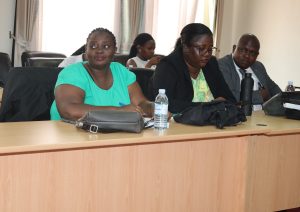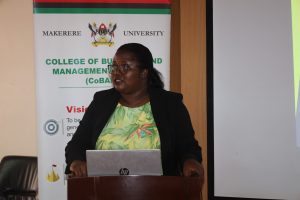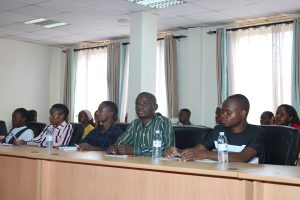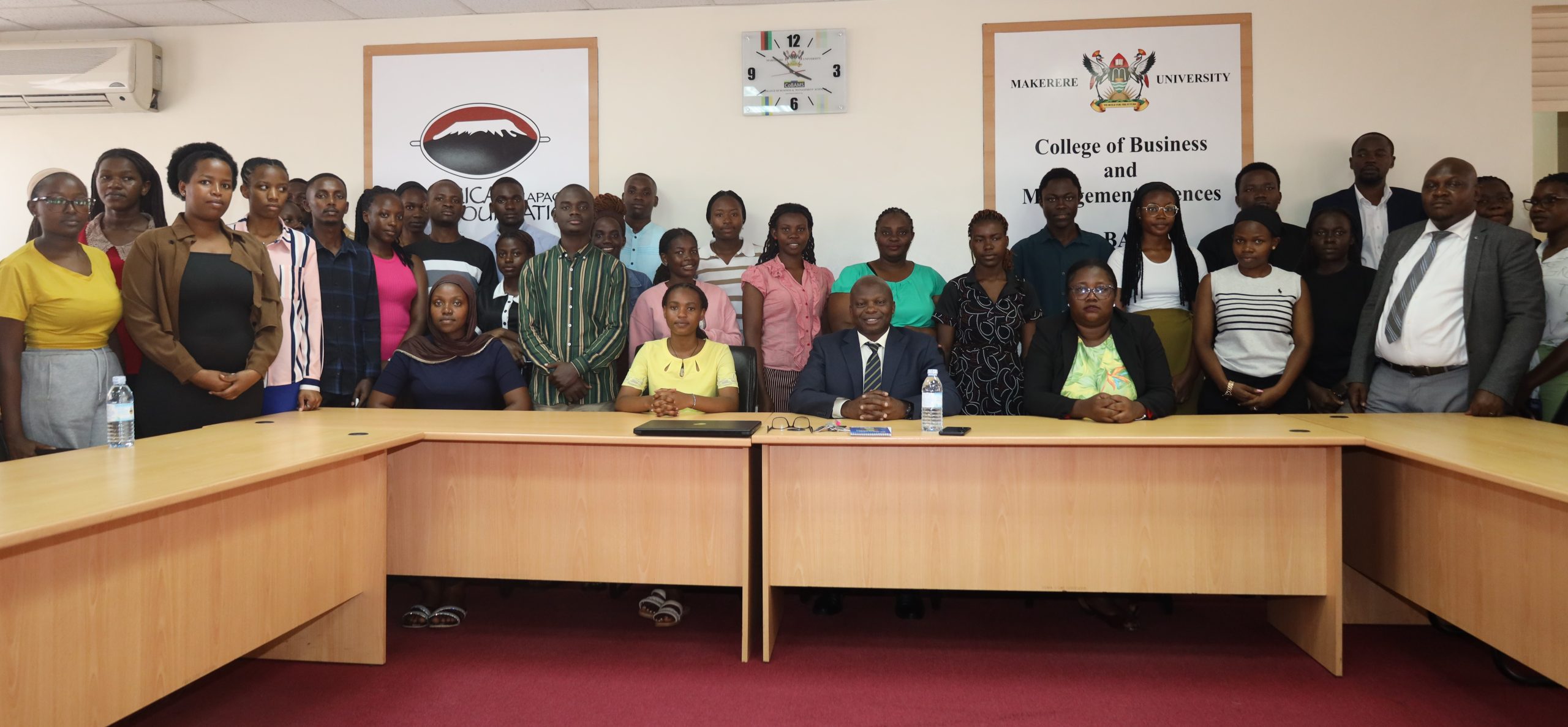By Moses Kibirango
September 23, 2025: The Intellectual Property Management Office at Makerere University has underscored the need for staff and students to recognize the value of their intellectual creations, which involves taking deliberate steps to protect them.
The message was relayed during the sensitization meeting held on 23rd September 2025 at the College of Business and Management Sciences (CoBAMS).
Addressing the participants, the team from the Intellectual Property Management Office highlighted that Intellectual Property (IP) is one of the most important drivers of innovation.

The Speakers from the Intellectual Property Management Office at Makerere University consisted of the following members of staff: Ms. Esther Kabinga, Mr. Peter Eneru and Ms. Fazilah Nakabugo.
Defining Intellectual Property
The IP Manager at Makerere University, Ms. Esther Kabinga explained that intellectual property refers to “creations of the mind” such as inventions, literary and artistic works, industrial designs, and symbols. These can be safeguarded under legal regimes such as patents, copyrights, trademarks, and industrial design rights.
“For you to benefit from these creations, what you seek to protect must be new, demonstrate technological advancement, and provide a benefit to society,” Ms. Kabinga informed the audience, stressing the legal thresholds innovators must meet before their work can qualify for protection.
She pointed out that failure to protect innovations exposes creators to the risk of losing ownership, recognition, and potential financial benefits.
Universities as Engines of IP

According to Ms. Kabinga, Universities occupy a unique position in the intellectual property ecosystem. She stated that universities are not only centers of knowledge creation, but also custodians of research that can be transformed into marketable solutions.
“At Makerere University, the IP policy is clear. If a staff member develops an invention using university resources, the intellectual property belongs to the institution. However, students generally own the rights to innovations developed during their studies,” she said.
The policy permits Makerere University to retain a royalty-free license to use student-created work for teaching and research purposes, in addition to, enabling students to commercialize their innovations. This arrangement, the Intellectual Property Management Office argued, balances institutional interests with individual incentives, and encourages both staff and students to innovate without fear of losing recognition.
Mr. Peter Eneru emphasized that creating awareness and understanding of the IP policies within higher education institutions is critical. “Some students and staff are not fully aware of how intellectual property works. They often give away their ideas unknowingly, or fail to pursue protection,” he said.
Lessons from the Global Stage
The Intellectual Property Management Office team drew comparisons between Uganda and global examples, particularly highlighting South Korea as a case study of how investment in intellectual property can transform a nation’s fortunes.
“In the 1960s, South Korea was among the world’s poorest nations. Today, it is the world’s 10th largest economy, home to companies such as Samsung, LG, and Hyundai,” Ms. Kabinga noted. “These companies are built on strong intellectual property portfolios, and when we buy their products, we directly contribute to their economy. That is the power of intellectual property.”
She stressed that higher education institutions in Africa must learn from such models by creating strong innovation ecosystems that combine teaching, research, and commercialization.
The High Cost of Infringement
The Speakers also underscored the risks of intellectual property infringement citing hih-profile global disputes. For instance, the legal battle between Apple and Samsung, where Apple was awarded $1.05 billion in damages in 2012 after a U.S. court found Samsung guilty of patent infringement.
“Such cases prove to us that intellectual property is not just an academic issue. It is a matter of survival for companies and economies. Without strong protection and enforcement, innovators lose out, and imitators thrive,” said Ms. Kabinga.
Building a Culture of Protection
Beyond legal battles, the presenters emphasized the importance of building a culture where researchers and students view intellectual property as part of their academic journey.
“Universities must not only produce graduates, but also innovators,” Ms. Fazilah said. “We want our students to graduate with knowledge, but also with protected ideas that can contribute to Uganda’s economic development.”
She noted that the university has put in place mechanisms to assist innovators, including guidance on filing for patents and copyrights, and training sessions on how to recognize and protect intellectual assets.
Call to Action

Ms. Kabinga issued a strong appeal to both students and researchers. “Intellectual property rights are among the most powerful tools for development. We encourage our academic community to come up with ideas, to protect them, and where possible, use them as sources of income,” she said.
She added that institutions such as Makerere University must act as bridges between research and industry, ensuring that innovations do not remain on the shelves, but are translated into real-world applications.
Towards an Innovation-Driven Economy
The Seminar is aligned to Makerere University’s broader push to strengthen Uganda’s position in the global knowledge economy. The Intellectual Property Management Office staff, stressed that Uganda seeks to industrialize, universities must take a lead role in producing and protecting innovations that can compete internationally.
“In today’s world, intellectual property is no longer a luxury—it is a necessity,” Ms. Kabinga concluded. “For Uganda to grow, we must recognize that knowledge is capital, and protecting it, is the first step to unlocking its full potential.”

